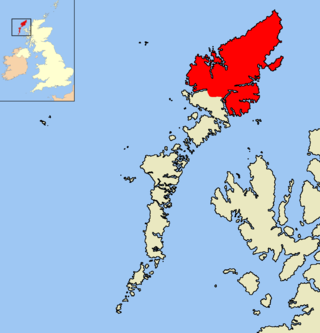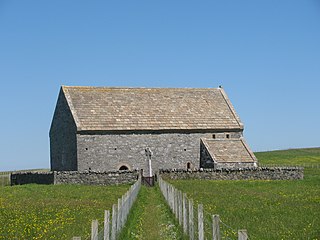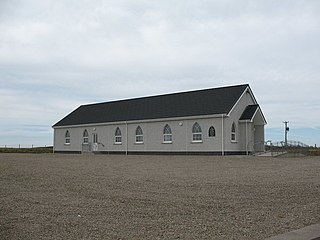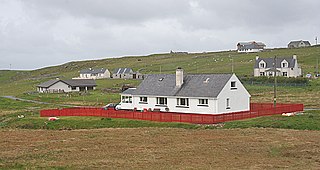
The Isle of Lewis or simply Lewis is the northern part of Lewis and Harris, the largest island of the Western Isles or Outer Hebrides archipelago in Scotland. The two parts are frequently referred to as if they were separate islands. The total area of Lewis is 683 square miles (1,770 km2).

Ness is the northernmost part of the Isle of Lewis, a community consisting of about 16 villages, including Lionel, Habost, Swainbost, Cross, North and South Dell, Cross Skigersta, Skigersta, Eorodale, Adabroc, Port of Ness, Knockaird, Fivepenny and Eoropie. It was the most north-westerly community in the European Union, when the United Kingdom was a member. Its most northerly point is the Butt of Lewis. The name Ness derives from the old Norse for headland and many of the other place names in the area also have a Norse origin.

Barvas is a settlement, community and civil parish on the Isle of Lewis in Scotland. It developed around a road junction. The A857 and A858 meet at the southern end of Barvas. North is the road to Ness; west takes the traveller to Carloway and the West Side; south runs the road to Stornoway. According to the 2011 Census it still has the highest concentration of Scottish Gaelic speakers in Scotland with 2,037.

Bragar is a village on the west side of the Isle of Lewis in the Outer Hebrides, Scotland, 14 miles from the island's only town, Stornoway. Bragar is within the parish of Barvas, and is situated on the A858 between Carloway and Barvas.

Carloway is a crofting township and a district on the west coast of the Isle of Lewis, in the Outer Hebrides, Scotland. The district has a population of around 500. Carloway township is within the parish of Uig, and is situated on the A858.
John Munro, was a Scottish soldier and poet who won the Military Cross during the First World War. He was killed in action three days later while serving as a 2nd Lieutenant with the 7th Battalion Seaforth Highlanders during the 1918 Spring Offensive. Lt. Munro, writing in his native Gaelic as Iain Rothach, came to be ranked by critics alongside the major war poets. Tragically, only three of his poems are known to survive. They are Ar Tir, Ar Gaisgich a Thuit sna Blàir, and Air sgàth nan sonn.

Carinish, is a hamlet on North Uist, in the Outer Hebrides, Scotland. It is in the south of the island, about two miles from the causeway to Benbecula. The hamlet is known for the Carinish Stone Circle and the Trinity Temple. Carinish is within the parish of North Uist and is situated on the A865.
Eilean Chaluim Chille is an unpopulated island in the Outer Hebrides.

St Moluag's church is a church in the village of Eoropie in Ness in the Isle of Lewis in Scotland. It is one of the busiest visitor attractions in Ness, due to historical importance and because it is easily accessible from the road along a footpath.

Little Bernera is a small island situated off the west coast of the Isle of Lewis in the Outer Hebrides.

Ardroil is a village on the Isle of Lewis in the Outer Hebrides, Scotland. Ardroil is within the parish of Uig.

Mealista was a township in the west of the Isle of Lewis. It is currently largely uninhabited due to the Highland Clearances, which occurred there in 1838. The beach is a visitor attraction.
Pabay Mòr or Pabaigh Mòr is an uninhabited island in the Outer Hebrides of Scotland.

Borve is a village on the west side of the Isle of Lewis in Scotland, 17 miles from the island's only town, Stornoway.

North Dell is a village on the Isle of Lewis in the community of Ness, in the Outer Hebrides, Scotland. North Dell is within the parish of Barvas. It lies 5 km south of the Butt of Lewis, between the settlements of South Dell and Cross and comprises 22 crofts. North Dell is reputed to be the best village for the growing of potatoes in Lewis – along with Garrabost in Point!

Eoropie is the most northerly village on the Isle of Lewis in the parish of Ness, in the Outer Hebrides, Scotland. Eoropie is within the parish of Barvas. The Teampull Mholuaidh is to be found here. Eoropie is situated at the end of the B8013 and B8014 roads, from Lionel and Port of Ness, respectively.

Aird Uig is a village on the Isle of Lewis, in the Outer Hebrides, Scotland. Aird Uig is within the parish of Uig, and is situated on the C40 minor road which joins to the B8011 at Timsgarry. The township includes 700 hectares of common grazings to the east and west of the village.

Timsgarry is a village on the Isle of Lewis, in the Outer Hebrides, Scotland. Timsgarry is home to the Baile na Cille Church and the Uig Museum, noted for its giant Chessmen, discovered in the sands in 1831.
Aonghas Caimbeul, alias Am Puilean, was a Scottish Gaelic Bard, war poet, and memoirist.

South Galson is a settlement on the northwest coast of the Isle of Lewis in the Western Isles of Scotland. It is 11 km southwest of Port of Ness. The Galson Primary School closed in 1996. The populations of North Galson, South Galson, and Melbost were 149 in 1999.

















